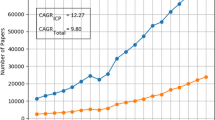Abstract
This study on research collaboration (RC) is an attempt to estimate the degree of internationalization of academic institutions and regions. Furthermore potential influences of RC on excellence initiatives of modern universities are investigated relying on source data obtained from SCImago Institutions Rankings. A positive correlation exists between the degree of collaboration and the normalized impact. However, in contrast to output the normalized impact increase progression is non-linear and fluctuating. Differences occur regarding output volume and normalized impact at geographical region level for the leading universities. Different patterns of the Brute force distribution for each collaboration type were also observed at region level as well as at subject area level. A continuously reduced percentage of the domestic (non-collaboration) academic output is a world trend, whereas a steady increase of “international + national” collaboration is observed globally, however, less distinctive in Asia than in the other regions. The impact of Latin American papers originating from domestic production as well as from national collaboration remains considerably below world average values.










Similar content being viewed by others
Notes
This number represents the sum of all publications calculated in SCImago Institutions Rankings (SIR) from each university’s contribution and does not consider any overlaps originating from joint publications.
“Arts & Humanities” are even more different, however, the number of publications is too low in this field which makes further comparisons less relevant.
References
Bordons, M., Gómez, I., Fernández, M. T., Zulueta, M. A., & Mendez, A. (1996). Local, domestic and international scientific collaboration in biomedical research. Scientometrics, 37(2), 279–295.
Gazni, A., & Didegah, F. (2011). Investigating different types of research collaboration and citation impact: A case study of Harvard University’s publication. Scientometrics. doi:10,1007/s11192-011-0343-8.
Glänzel, W. (2001). National characteristics in international scientific co-authorship. Scientometrics, 51(1), 69–115.
Glänzel, W., & Schubert, A. (2001). Double effort = double impact? A critical view at international co-authorship in chemistry. Scientometrics, 50(2), 199–214.
Glänzel, W., Schubert, A., & Czerwon, H. J. (1999). A bibliometric analysis of international scientific cooperation of the European union (1985–1995). Scientometrics, 45(2), 185–202.
Gorraiz, J., Reimann, R. & Gumpenberger, C. (2011, July 04–07). The importance of bilateral and multilateral differentiation in the assessment of international collaboration—a case study for Austria and six countries. Proceedings of the ISSI 2011 Conference in Durban, South Africa (Vol. 1, pp. 236–248).
Heinze, T., & Kuhlmann, S. (2008). Across institutional boundaries? Research collaboration in German public sector nanoscience. Research Policy, 37, 888–899.
Hsu, J., & Huang, D. (2011). Correlation between impact and collaboration. Scientometrics, 86(2), 317–324. doi:10.1007/s11192-010-0265-x.
Katz, J. S., & Hicks, D. (1997). How much is a collaboration worth? A calibrated bibliometric model. Scientometrics, 40(3), 541–554.
Katz, J. S., & Martin, B. R. (1997). What’s research collaboration? Research Policy, 26(1), 1–18.
Kruskal, W. H., & Wallis, W. A. (1952). Use of ranks in one-criterion analysis of variance. Journal of the American Statistical Association, 47(260), 583–621.
Lee, K., Brownstein, J. S., Mills, R. G., & Kohane, I. S. (2010). Does collocation inform the impact of collaboration? PLoS ONE, 5(12), e14279.
Leiden Ranking (2011). http://www.cwts.nl/ranking/LeidenRankingWebSite.html.
Leimu, R., & Koricheva, J. (2005). Does scientific collaboration increase the impact of ecological articles? BioScience, 55, 438–443.
Levitt, J. M., & Thelwall, M. (2010). Does the higher citation of collaborative research differ from region to region? A case study of economics. Scientometrics, 85, 171–183.
Liao, H. C. (2011). How to improve research quality? Examining the impacts of collaboration intensity and member diversity in collaboration networks. Scientometrics, 86(3), 747–761. doi:10.1007/s11192-010-0309-2.
Narin, F., Stevens, K., & Whitlow, E. S. (1991). Scientific cooperation in Europe and the citation of multinationally authored papers. Scientometrics, 21(3), 313–323.
Ortega, J.L. (2011). Collaboration patterns in patent networks and their relationship with the transfer of technology: the case study of the CSIC patent. Scientometrics. doi:10.1007/s11192-011-0363-4.
Persson, O. (2010). Are highly cited papers more international? Scientometrics, 83(2), 397–401.
Persson, O., Glänzel, W., & Danell, R. (2004). Inflationary bibliometric values: The role of scientific collaboration and the need for relative indicators in evaluative studies. Scientometrics, 60(3), 421–432.
SCImago research group (2009). SIR—SCImago institutions rankings. http://www.scimagoir.com Accessed Feb 2011.
Sooryamoorthy, R. (2009). Collaboration and publication: How collaborative are scientists in South Africa? Scientometrics, 80(2), 419–439.
Van Leeuwen, T. N., & Tijssen, R. J. W. (2007). Strength and weakness of national science systems. A bibliometric analysis through cooperation patterns. Scientometrics, 79(2), 389–408.
Author information
Authors and Affiliations
Corresponding author
Rights and permissions
About this article
Cite this article
Benavent-Pérez, M., Gorraiz, J., Gumpenberger, C. et al. The different flavors of research collaboration: a case study of their influence on university excellence in four world regions. Scientometrics 93, 41–58 (2012). https://doi.org/10.1007/s11192-012-0638-4
Received:
Published:
Issue Date:
DOI: https://doi.org/10.1007/s11192-012-0638-4




